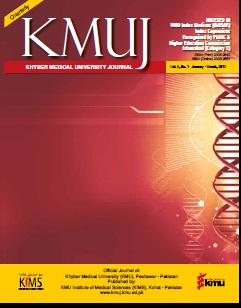ETIOLOGICAL STUDY OF SEIZURES IN NEONATES
Main Article Content
Abstract
Objective: To determine the incidence and etiology of seizures among neonates admitted to Nursery unit of Hayatabad Medical Complex, Peshawar.
Methodology: This descriptive study was conducted at Hayatabad Medical Complex, Peshawar, Pakistan from January to December 2011. During the study period, all admitted neonatal cases were examined and data on neonatal seizures was ascertained. Among admitted neonates, having seizures either at presentation or during their stay in the hospital were investigated for its cause. Cases with clinical diagnosis of neonatal tetanus were excluded from the study. In order to determine the etiology of seizures, metabolic profile including blood glucose, serum calcium and sodium levels and other necessary tests were done in all cases. A proforma was designed comprising detailed history, general physical examination, systemic examination and relevant investigations. Data was recorded for analysis.
Results: Seizures were observed in 159/1583 (9.95%) of neonatal admissions and 55.88% neonates had seizures during the first 72 hours of life. Commonest types of seizures observed in this study were subtle (39.6%) followed by tonic (31.4%), clonic (25.10%) and myoclonic (3.70%) seizures. Hypoxic ischemic encephalopathy was found to be the commonest cause (44%) of neonatal seizures, followed by hypoglycemia (18.8%) and hypocalcemia (12.5%). Casesof hypoxic ischemic encephalopathy were associated with higher mortality (42.85%) as compared to cases with metabolic seizures.
Conclusion: Neonatal seizures were found in about 10% of neonatal admissions and presented most commonly as subtle type. Birth asphyxia was the commonest etiology of neonatal seizures, followed by the metabolic causes.
Key words: Seizures, Etiology, Neonates, Birth Asphyxia, Hypoglycemia, Hypocalcemia.
Article Details
Work published in KMUJ is licensed under a
Creative Commons Attribution 4.0 License
Authors are permitted and encouraged to post their work online (e.g., in institutional repositories or on their website) prior to and during the submission process, as it can lead to productive exchanges, as well as earlier and greater citation of published work.
(e.g., in institutional repositories or on their website) prior to and during the submission process, as it can lead to productive exchanges, as well as earlier and greater citation of published work.
References
World health report 2005: Make every mother and child count. Geneva: WHO; 2005.
Jalil F. Perinatal health in Pakistan: A review of the current situation. Acta Paediatr 2004; 93: 1273-79.
Bhutta ZA. Maternal and child health in Pakistan: challenges and opportunities. Oxford University Press; 2004.
Lawrence R, Mathur A, Nguyen. A pilot study of continuous limited-channel EEG in term infants with encephalopathy. J Pediatr 2009; 154(6): 835-41.
Stone BS, Zhang J, Mack DW. Delayed neural network degeneration after neonatal
hypoxia-ischemia. Ann Neurol 2008; 64(5): 535-46.
Sattar SA, Hameed MN, Maqbool S. Incidence
and Etiology of Neonatal Seizures. Pak Petiatr J 2006; 30(4): 168-73.
Behrman RE, Kliegman RIV, Jensao HB. Nelson’s Textbook of Pediatrics. 19th NILEd. Philadelphia: W.B Saunders; 2011. P. 2033-2037.
Tekgul H, Gauvreau K, Soul J, Murphy L, Robertson R, Stewart J, et al. The current etiologic profile and neurodevelopmental outcome of seizures in term newborn infants. Pediatrics 2006; 117(4): 1270-80.
Murray DM, Boylan GB, Ali I, Ryan CA, Murphy BP, Connolly S, et al. Defining the gap between electrographic seizure burden, clinical expression and staff recognition
of neonatal seizure. Arch Dis Child 2008; 93: 187-91.
Shellhas RA, Gallagher PR, Clancy RR. Assessment of Neonatal Electroencephalography
(EEG) Background by Conventional
and Two Amplitude-Integrated EEG Classification Systems. J Pediatr 2008; 153: 369-74.
Carmo KB, Barr P. Drug treatment of neonatal seizures by neonatologists and paediatric neurologists. J Paediatr 2005; 41(7): 313-316.
Ronen GM, Buckley D, Penney S. Long-term prognosis in children with neonatal seizures: a population-based study. Neurology
; 69(19): 1816-22.
Kwon JM, Guillet R, Shankaran S. Response to correspondence on “Clinical seizures in neonatal hypoxic-ischemic encephalopathy
have no independent impact on neurodevelopmental outcome. J Child Neurol 2011; 26: 533-34.
Schmitt B, Wohlrab G, Sander T, Steinlein OK, Hajnal BL. Neonatal seizures with tonic clonic sequences and poor developmental
outcome. Epilepsy Res 2005; 65(3): 161-8.
Mwaniki M, Mathenge A, Gwer S, Mturi N, Bauni E, Charles RJC, et al. Neonatal seizures in rural Kenyan district hospital: aetiology, incidence and outcome of hospitalization.
BMC Medicine 2010; 8: 8-16.
Gabriel M, Ronen, Sharon Penny, Wayne Andrews. The epidemiology of clinical neonatal seizures in New Found land: A population based study. J Pediatr 1999; 134: 71-75.
Lawn JE, Wilczynska-Ketende K, Cousens SN. Estimating the causes of 4 million neonatal deaths in the year 2000. Int J Epidemiol 2006; 35(3): 706-18.
Armstrong-Wells J, Johnston SC, Wu YW, Sidney S, Fullerton HJ. Prevalence and predictors of perinatal hemorrhagic stroke: Results from the Kaiser pediatric stroke study. Pediatrics 2009; 123: 823-8.
Idro R, Gwer S, Kahindi M, Gatakaa H, Kazungu T, Ndiritu M, et al. The incidence, aetiology and outcome of acute seizures in children admitted to a rural Kenyan district hospital. BMC Pediatr 2008; 8: 5.
Gebremariam A, Gutema Y, Leuel A, Fekadu
H: Early-onset neonatal seizures: Types, risk factors and short-term outcome. Ann Trop Paediatr 2006; 26(2): 127-31.
Glass HC, Pham TN, Danielsen B, Towner D, Glidden D, Wu YW. D, Glidden D, Wu YW. Antenatal and Intrapartum Risk Factors for seizures in term newborns: A Population-based study in California. J Pediatr 2009; 154(1): 24-28.
Malik BA, Butt MS, Sharmoon M, Tehseen Z, Fatima A, Hashmat N. Seizure etiology in the newborn period. J Coll Physicians Surg Pak 2005; 15: 786-90.
Glass HC, Glidden D, Jeremy RJ, Barkovich AJ, Ferriero DM, Miller SP. Clinical neonatal
seizures are independently associated with outcome in infants at risk for hypoxic-
ischemic brain injury. J Pediatr 2009; 155(3): 318-23.
Azam M, Jamal M. Neonatal seizures; classifications, diagnosis and treatment. Pak Pediatr J 1997: 21: 137-45.
Krakauer MG, Carter BS. Neonatal Hypoxia
and Seizures. Pediatrics in Review 2012; 33(9): 387-97.
